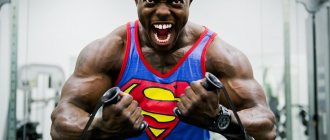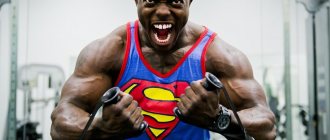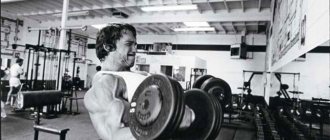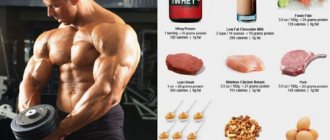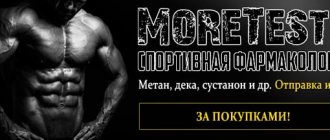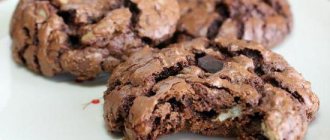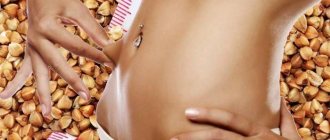At the moment when a person feels that his muscles are bursting from the inside, he feels the “pumping” effect. At this moment, the muscle tissue noticeably increases in volume due to the strong filling of the muscles with blood and swelling. The reason for this effect is the intake of large amounts of sugar into the body, as well as other substances that actively attract water. Moreover, the membrane tissue of cells at this moment is the most permeable.
In total, there are three types of pumping, depending on the means of achieving the effect of expansion and compaction: productive, with the help of sports nutrition and cosmetic. Let's look at each of them separately to understand how to pump up your muscles to the fullest extent.
What is Pumping
Literally, pumping is pumping, filling. This term comes from the English verb “to pump”. Frequent repetition of the same movement increases muscle blood flow and leads to tissue swelling. At the same time, the concentration of sugar and water increases many times over, the permeability of the cell membrane increases, which creates a feeling of muscle expansion in a specific area of the body.
The pumping effect can be achieved by gradually reducing the weight of the sports equipment, but increasing the speed of training movements and the number of repetitions. During training, it is necessary to maintain amplitude and perform each action as intensely as possible, overcoming pain. At the end of the exercise, the athlete increases the pace, while the blood supply to the tissues increases, and at the end of the workout the muscles increase in volume by up to 20%.
General information
The lion's share of modern terms applicable to bodybuilding came to us from English. pumping was no exception. The term literally translates as “pumping.”
By and large, this is true. After all, the process that will be described below allows you to significantly increase the volume of blood entering the muscle. As a result, the muscle group that has become the object of study increases in size before our eyes. But this does not mean that the muscles remain like this forever. If that were the case, then everyone around would already be bigger than Dwayne Johnson. The “pumping up” effect lasts no more than 20 minutes. Then the muscles return to their usual size. This period depends on the individual characteristics of the body. But, as you probably already guessed, short-term gains in muscle volume are just the tip of the iceberg. And the main reason why such a technique as pumping is used lies much deeper. This will be discussed a little below.
Body reaction to pumping training
Pumping works physiologically this way:
- The same movements, when duplicated at high speed, lead to the nervous system working in a stressful mode. The brain centers promote increased acceleration of blood flow and send all the necessary substances to the tissues;
- Muscle fibers facilitate the penetration of blood cells into them, which cannot exit immediately due to compression of the capillaries and high tension;
- When the exercise is repeated after a long break, the pressure in the fibers decreases and the blood gradually flows in the opposite direction. Ultimately, the muscle tissue returns to its normal state.
Muscle pumping does not consolidate the result and is called “cosmetic”. Most often it is used by bodybuilders in competitions before going on stage. But if you wish, you can try to develop it into a “productive” form.
“Productive” pumping is adding exercises without rapid repetitions. At some point, increased blood flow is formed, which leads to euphoria. From a psychological point of view, this gives strength and has a great effect on the intensity of the next workout. This constant practice warms up the fascia (the “bags” that contain the muscles) and makes them easier to stretch.
You can achieve muscle swelling with the help of sports nutrition and pharmacology - injections, tablets. But the so-called “Pharmacological” pumping proceeds artificially and can be fraught with health hazards if the sports nutrition is improper.
Video: What is pumping. Its varieties
Movement speed
To feel what pumping is on your muscles, you need not only to take small working weights. It is also important to determine the appropriate intensity of traffic. This parameter is individual for each organism. Determining the appropriate intensity is not difficult. You just need to spend a few sessions experimenting with speeds in each new approach. And carefully analyze the result. The good thing about the intense pace is that it allows you to engage both fast-twitch and slow-twitch fibers, as well as small muscle groups that are not activated at slow speeds. In this case, the weight of your projectile should be 50% less than the maximum possible. The optimal number of repetitions in this case is about 20.
A slow tempo also has its merits. If a high speed of repetitions involves more muscles, then a low speed allows you to accumulate the load on the target muscle group. This option is better for those whose goal is to increase muscle size. In this case, the working weight is already up to 70% of the maximum allowable. And the number of repetitions is reduced to about 10.
Pros and cons of pumping
Advantages:
- Pumping does not imply the use of maximum weights. Ligaments and joints are not overloaded during the “saving” mode.
- Since the work is carried out mainly with light weights, the muscles are not damaged as much, which means they recover faster. This same point can also be attributed to the disadvantages of pump training (more on this below);
- The worked part of the body from the rush of blood becomes outwardly attractive - the most convex and prominent;
- The muscle fibers become clogged with lactic acid. This activates increased production of testosterone and somatotropin (growth hormone);
- With the help of open capillaries, thinned membranes of dilated cells and accelerated blood flow, oxygen and nutrients are very quickly delivered to the muscles and are absorbed many times better;
- A dense “cover” is formed around the muscle with the help of connective tissue, which serves as protection from vibrations, shocks, etc. Its advantages are that during training it stretches gradually, its length reserve increases, it can withstand maximum loads and does not tear;
- Constant pumping burns excess subcutaneous fat and forms a clear profile in a very short time.
Flaws:
- The biggest disadvantage of pump training is that you cannot build muscle mass with it. Many studies talk about this. But, 1 or 2 times a month, an athlete can practice pump training in order to “surprise the muscles,” since everyone knows that they get used to monotonous training;
- Each pumping workout is done in the final approach until severe pain occurs. This is not always a desirable and pleasant activity after a heavy strength training session;
- If you overuse intensive and long-term “cosmetic” pumping, it leads to muscle burning. This is dangerous for people who have difficulty gaining weight;
- The nervous system is exhausted - a sign of a stressful state comes from pumping to the brain. The disadvantages are that if repeated frequently it leads to mental overload.
Types of Pumping training
Pumping muscles with blood is carried out in several ways. Complexes can be alternated and combined. But not a single pumping workout is possible without strength loads.
Standard workouts
This complex includes basic exercises with dumbbells or a barbell. A large number of repetitions are performed with a minimum of intervals. You can also use the simplest and most well-known exercise for pumping the pectoral muscles - push-ups.
Drop set
This method is also called “Dropping” and consists of performing strength work with a minimum break between approaches and gradually reducing the weight. An example of such pumping training could be the following sets:
Standing dumbbell bicep curls:
- 2 sets of 10 times with a 5-kilogram apparatus in each hand;
- The third approach is 8 times with the same weight, 4 and 5 – 16 times each with 3 kg dumbbells;
- Stretching exercise with final contraction of muscle fibers.
Calf raises on a Smith machine (working weight - 100 kg):
- 4 times 100 kg;
- 3 times 80 kg and 60 kg.
You will find all the necessary information about drop sets in this article.
Super set
It is the most effective pumping method, which combines two different exercises for one muscle group or muscle groups located next to each other. It is necessary to perform elements without skipping repetitions, respites or breaks, otherwise the effectiveness of pumping training will decrease. The athlete can choose the exercises and number of repetitions.
Best pairings for a super set:
- Biceps + triceps - a combination of dumbbell extension from behind the head in a sitting (or lying) position with a classic biceps curl;
- Biceps femoris + quadriceps femoris - performing seated leg extensions and leg presses with working weight.
We wrote in detail about supersets in this article.
Peak contraction
The exercises are performed as usual, but during the approach it is necessary to hold at the very peak for a couple of seconds. For example, when bending your arms with dumbbells, the delay occurs at the highest point.
Partial repetition
This method is recommended to be performed before completing a workout, when you feel tired. Pumping exercises with partial repetitions are very effective, although they are not done at full strength, but at 1/2-1/4 amplitude (shortened amplitude). This may cause severe tingling or burning in the muscles, but this is normal. It is also necessary to observe the number of repetitions from 8 to 10 or more.
Pre-fatigue
This is a very heavy type of pump, but quite effective, with a long-lasting effect. The bottom line is that you initially need to isolate the muscle, and then load it almost to failure. The training program may include the following exercises:
- For triceps: a combination of bench press with a narrow grip and extension of the arms in a block machine;
- On the legs: seated leg extension combined with classic squats.
It is better for novice athletes not to use this type due to its increased risk of injury.
Burning
First, the exercises are performed as usual. But as soon as the athlete feels tired, he begins to sharply increase his speed until his power reserves are fully exhausted.
How to do it right so as not to kill yourself
Everything is good in moderation. This principle must be strictly observed in pumping. If you feel that you are too tired and can’t do any more, you don’t need to overstep yourself. sharp muscle pain is a signal that the exercise should be stopped. Monitor the condition of your cardiovascular system. During the pumping process, you feel nauseous, dizzy, faint, or experience bleeding; pumping must be stopped immediately and consult a doctor. Pumping cannot be carried out without special training. It must be combined with strength training without fail.


